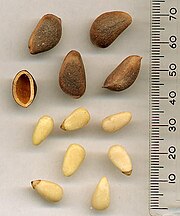yeah we have nuts for birds in our garden and in the winter we also use fat!
Well done. And dont forget the water when evertthing is iced over !
yeah we have nuts for birds in our garden and in the winter we also use fat!
Pigs do. I think humans can to if they are well boiled, but am not sure. there is at certain times of the year in Brazil a nut from a type of pine tree, which is good to eat after boiling. It has a sort of leathery shell that yo can open with your finger nails and peal back to make the nut "pop out" The nut is about 1 cm long and sort of almond shaped. After being boilded, it is soft, a little stiocky and mildly sweet. I think the boiling converts some of the more complex starches in to sugars. I have tasted acrons. As I recall they are quite bitter. Brazil has very few if any oaks, so this is from long ago.can we eat acorns?
Spud:
Are you an Ornithologist?
Quite possible, but when living in US I never had one - only heard of them. They are very cheap when in season here.billy T you mean a pine nut?...

Wikipedia said:Pine nuts are the edible seeds of pines (family Pinaceae, genus Pinus). About 20 species of pine produce seeds large enough to be worth harvesting; in other pines the seeds are also edible, but are too small to be of value as a human food
.
.
.
Species and geographic spread
In Europe, pine nuts come from the Stone Pine (Pinus pinea), which has been cultivated for its nuts for over 6,000 years, and harvested from wild trees for far longer. The Swiss Pine (Pinus cembra) is also used to a very small extent.
In Asia, two species are widely harvested, Korean Pine (Pinus koraiensis) in northeast Asia (the most important species in international trade), and Chilgoza Pine (Pinus gerardiana) in the western Himalaya. Four other species, Siberian Pine (Pinus sibirica), Siberian Dwarf Pine (Pinus pumila), Chinese White Pine (Pinus armandii) and Lacebark Pine (Pinus bungeana), are also used to a lesser extent.
In North America, the main species are three of the pinyon pines, Colorado Pinyon (Pinus edulis), Single-leaf Pinyon (Pinus monophylla), and Mexican Pinyon (Pinus cembroides). The other eight pinyon species are used to a small extent, as are Gray Pine (Pinus sabineana), Torrey Pine (Pinus torreyana) and Sugar Pine (Pinus lambertiana). In the United States, pine nuts are mainly harvested by Native American tribes; in many areas, they have exclusive rights to the harvest.
Viewed 20/02/08 at 11:04
The eatable seed does, but not the nut's shell. It is more definitely pointed at one end and sometimes with a hint of fiber, sort of hairs, sticking out of the pointed end. Surely the Brazilian ones are just a variety, as there are many. Thank for the infro.I dont know, do they look like this?...
Oh lordy yes indeed. There are several species of macadamias, for example, and some of them are poisonous to humans.are there any nuts that are inedible to humans?
Don't have a problem here with things freezing over but I have planted many native and endemic trees and shrubs for the wildlife. I live in one of the last strongholds of the Glossy Black Cockatoo whose favourite food is the seeds of Casuarina littoralis, black She-oak so I've planted a few of these as well as butterfly attracting and nectar providing plants for butterflies and honeyeaters.
Unfortunately for me, my fruit trees are a huge hit with local lorikeets, rosellas, king parrots and fruit bats ( flying foxes).
I gather that's not the bird we call Black Palm Cockatoo, large and black with red cheeks, the poster child for the endangered species crusade. An American veterinarian/aviculturist was successful not only in breeding them domestically but in curing the disease that threatened to wipe out the species. As a result there are almost enough now in North America to sell to hobbyists. Much as that grates on the nerves of the green fundamentalists, it's the path to salvation for many species. 2008 may be the year when the number of breeding pairs of hyacinthine macaws (the crusade's other poster child) in American homes and aviaries exceeds the number in the shrinking Brazilian rain forest.Don't have a problem here with things freezing over but I have planted many native and endemic trees and shrubs for the wildlife. I live in one of the last strongholds of the Glossy Black Cockatoo. . . .
It's very difficult to cultivate vegetation that will attract only the desired species. America's subtropical cities like Los Angeles and Miami have huge breeding populations of feral psittacines of many species. The cultivated tropical foliage planted in those cities provides a more or less natural food source for these birds. They're inquisitive and adventurous enough to try anything that looks edible, so you might see multiple species of Amazons, conures and the occasional macaw feeding in the same garden.. . . . whose favourite food is the seeds of Casuarina littoralis, black She-oak so I've planted a few of these as well as butterfly attracting and nectar providing plants for butterflies and honeyeaters. Unfortunately for me, my fruit trees are a huge hit with local lorikeets, rosellas, king parrots and fruit bats ( flying foxes).
Coconut should be a seed because you can plant it and it will grow. But the coconut that you buy at the stores, the covering is taken off.
Cocoa bean is where chocolate comes from.....
